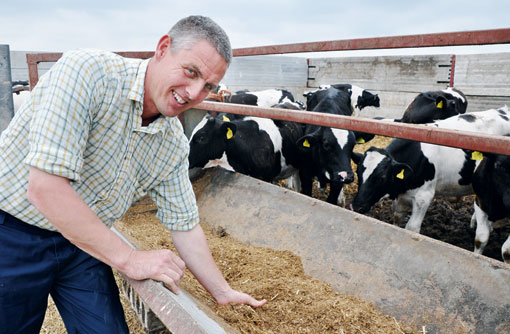Teamwork reaps benefits on beef finishing unit

Developing a farm-management strategy based on teamwork between the farmer, vet, nutritionist and other farm advisors, can maximise margins, reports Gemma Mackenzie.
Adopting a teamwork approach to farm management has paid dividends for Garry Allis, who currently finishes 700 predominantly black and white bulls a year on his open-air, corral-based rearing system at Furze Hill Farm, Bilsby, Lincolnshire.
Furze Hill is one of six farms undergoing changes as part of the KW Compass Programme, which aims to take farmers on a “journey of improvement”, based on teamwork.
Speaking at an open day for the programme, Mr Allis explained the farm’s improvement strategy (see below), which has resulted in him finishing cattle at a target 230kg deadweight from as young as 10 months of age. He achieves, on average, 1.2kg/day daily liveweight gain from birth to slaughter.
The focus is on the margin, rather than the value of the animal, and the push to finish cattle earlier is driven by a lack of growth between 13-15 months of age, added Mr Allis.
“The first project was getting the cattle vaccinated, and once we got the vaccination right, we changed into a high-protein diet, which made an instant impact.
“We are trying to get 230kg under 12 months of age, because we get a bonus if they are under a year old. In the future, the infrastructure will improve and the numbers will go up, because it’s all about unit cost, production and margin.”
On the move to an outdoor system, he said: “We decided to put everything outside because of a problem with pneumonia in the buildings, so we started building concrete panel pens.
“The construction is quite simple – they are all about 20ft long, and the animals eat up everything – it’s all ad lib. Every third day, we want to see the trough empty. There is definitely less bloat and less acidosis, meaning better growth rates, with this system in comparison to a barley system.”
KW nutritionist Michael Marsden said the aim was to spend the bulk of the feed costs in the first six months of life, when the bulls were growing rapidly, and lower the feed and management costs towards the end of the finishing period, when intake was high and growth low.
“Testosterone means that the bulls are going to put down good lean meat. In the first six months of life, it has the potential to really grow, and you really have to feed to that potential.”
The grower ration is higher in protein – approximately 16% – and consists of 44% maize, 17.5% of a rape seed meal, 16.5% of a wheat feed blend, 13.5% soya hulls, 6% of a soya-based product and 2.5% of vitamins, minerals and yeast.
The finisher ration is a lower-protein, moist feed containing 14% protein in the dry matter, equivalent to 12.5% on an 87% dry matter basis. Mr Allis also plans to introduce an intermediate ration in the future, introducing a moist feed earlier at the same specification as the dry grower feed.
With regards to animal health, vet Leanne Young from Fenwold Veterinary Practice said: “We came and looked at the pneumonia situation back in December 2009, and the red flag for us was the amount of pneumonia antibiotic he was going through – he was spending £11-12,000 on this alone every year.
“We therefore assume he has every strain of the pneumonia virus and we now use intranasal vaccine, which gives about three months cover. Anything under three months of age gets three shots, and any animals coming to the farm get an intranasal and a shot of antibiotics.”
Adam Buitelaar from Buitelaar International Trading, which buys the bulls, said using bulls from the dairy herd offered a solution to beef shortages, and units such as Mr Allis’ were an example of a simple, low labour, effective beef finishing system.
Farm Improvement Strategy
• Maximise early growth – protein increased in grower ration; sugar beet fed to maintain healthy rumen; moist feeds introduced to increase intakes.
• Reduce production costs – focus on growth rate to cut cost/kg liveweight gain.
• Monitor performance – new weighing system under construction as part of new handling system.
• Improve herd health – rigorous vaccination programme introduced to tackle pneumonia.
